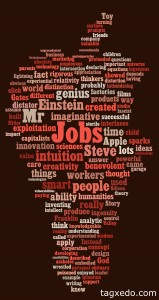Steve was among the greatest of American innovators – brave enough to think differently, bold enough to believe he could change the world, and talented enough to do it
Barack Obama
(cited in The Guardian, 2011)
The professional story tellers continue with the official presentations of stories across all media formats that become indistinguishable from one another in this age of convergence and multimodality. The version of Job’s obituary that appears in the online version of The Guardian newspaper begins with a video, and the video begins with an advertisement, and then continues with a story, which is as much about commercialism as it is about the subject’s passing.
The tradition of the bricks and mortar book continues although the speed of publication has become so shortened that it’s almost indistinguishable from electronic format and itself relies on electronic channels.
Jobs has been portrayed from all points of the spectrum from saintly, as portrayed in his sister’s eulogy, to just a regular guy with humble beginnings, as he portrayed himself in his Stanford commencement speech, to arch corporate villan, as portrayed by some activists, and to a fuller account as portrayed by his biographer, Walter Isaacson, who summarized his opinion in an article the New York Times.
Steve Jobs, living a remarkably private life in this time of multimodality, realized that he could exercise some power over at least the beginnings of his story after death. He is said to have authorized his biography so that his kids could know him (Barr and Gupta, 2011). But his story will continue and professional entertainers will continue to add to his story as Gladwell (2011) does in The Tweaker.
Absorbing Job’s story is not just about professional entertainers as it was in Kennedy’s time. Experiencing Job’s story involves assimilating microcontent forming a kaleidoscope of perspectives which together form his collaboratively told death story. Job’s death story is overflowing in microcontent produced through “mass amateurization” and as the metastory comes to a close Our Stories continue and we can see how stories are now told collaboratively across multimodalities in a mix of professional and amateur voices.
